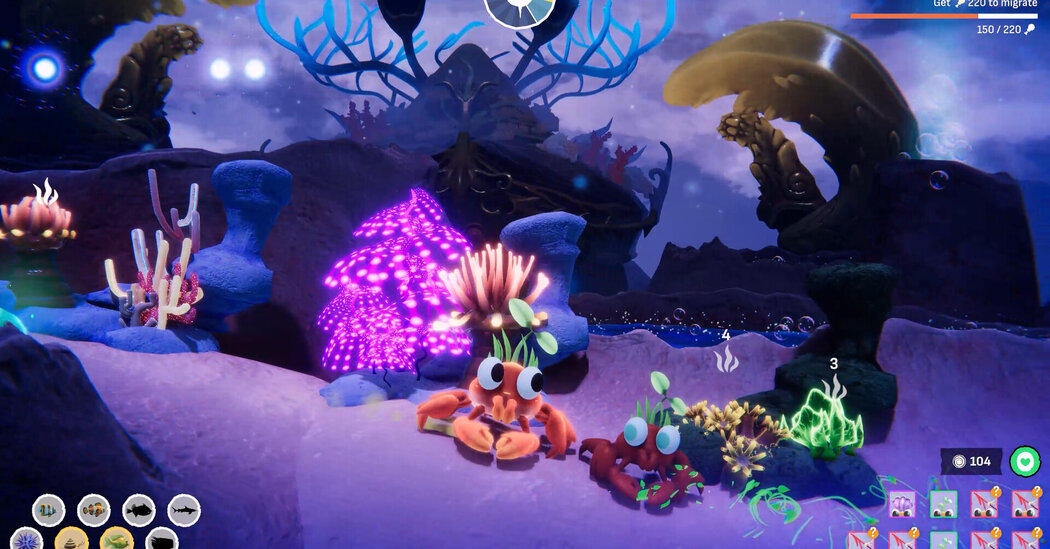During the early summer days of oppressive heat, Crab God, Riven and Rabbids: Legends of the Multiverse offer tantalizing virtual experiences in refreshing ocean biomes, a lush science fiction land and cool medieval villages.
Crab God
In a world of coral reefs, industrious sea creatures and dangerous predators, you are in debt to the eponymous Crab God. The offering begins as a Tamagotchi-style endeavor in which you must oversee round-eyed crablings with anthropomorphized names like Clawdette. They coo like babies as you hatch them, and then are given jobs to create a diverse aquatic biome.
But there’s deep strategy involved. Five types of crabs are protecting the lair and a precious egg that will evolve into the next crab god. Crablings build, garden and pay homage to the leering crustacean who looms large in the background. It’s all an effort to help the colony thrive on the sea’s bottom.
Because of the tactics and science involved, this 30-hour computer game is alluring in every way possible. I was drawn in by the balance needed to secure a thriving, stable ecosystem and details like the delightful sideways moves of a crabling holding a mallet.
Crab God, by the studio Chaos Theory, is part of a genre of climate games that make you cognizant of real-world environmental challenges. It won a Unity for Humanity Award because a healthy chunk of it deals with ocean preservation.
It does not bash gamers over the head about the climate crises at hand; Crab God excels by subtly weaving in affecting ideas. Early on, crablings energized by eating bubble kelp easily defeat intruders like an invasive darkspine starfish. Soon, an encyclopedia offers detailed information on every being from your encounters, somewhat like a Pokédex.
If you care for a deeper dive into helpful information, open the world map. To the calming sounds of light drums and synths, I discovered how sea turtles are being saved in the Conflict Islands in Papua New Guinea and how coral is being restored in Spain. Each time you discover a Stone of Preservation, you can choose one of three donations that the developers will make on your behalf.
Part of the thrill here is the similarity to building an aquarium, except this is set in the wild and the player is a kind of omniscient Jacques Cousteau. You can also feel your real-life frustrations melt away through a combination of relaxing music, burbling air bubbles and animated crab action.
Riven
Riven was the 1997 sequel to the graphically amazing Myst, a science fiction puzzle game full of environmental artwork that you click through to progress. Myst and Riven sold millions of copies, possibly because they could be seen as meditations on existential loneliness, aloneness and paranoia.
The Riven remake by Cyan Worlds is just as intensely mind-blowing, with its strange books that are portals to varied worlds. While it seems that you’re alone, you always think you’re being watched. Haunting, droning music intensifies this feeling as you search for a woman named Catherine and fight to free yourself from these unusual lands.
The primary change is in the gameplay. Players can finally move forward in a 3-D environment without clicking through the static screens of another era. It’s a joy to marvel at the sparkling waves of Temple Island as if I were atop some rocky Grecian isle staring into the ocean below. A steampunk gondola’s creaky movement frightened as I was chilling to the waves’ beat.
Because the game is also made for virtual reality, you can turn around and inspect things nearby. Clues can be almost invisible. But they’re everywhere, including on a tree trunk. A burl reveals an eye that opens and shuts. You’ve seen the eye before. But what does it symbolize? Keeping a notebook of clues is a necessity. Even today, Riven can be considered a work of enduring popular art — except for one overriding issue.
To move from scene to scene, software must load, and the load times are long. The minutes it took heated up my computer to the point I thought my graphics card would fail. The culprit was my gear. My three-year-old video card couldn’t take it. I soldiered on, playing a little at a time, decreasing the video fidelity to cool the laptop. Riven still looked impressive, but the distraction lessened its charm. Meticulously detailed artwork was rare in the 1990s, but now game environments are expected to pop with hyperrealism. For this remake, developers went too far.
The puzzles are brain-melters decades on, so much so that a reviewers guide included “gentle” and “strong” hints. The worry about my overheating computer, however, kept taking me out of the experience. The state-of-the-art computer specs needed here may prevent many from playing Riven. Instead of emphasizing photorealism, it would have been beneficial for the creators to have added more levels, puzzles and story to lure a new generation through this fantastical place.
Rabbids: Legends of the Multiverse
Rabbids could have been an inspiration for Minions. But they’re definitely ruder.
Ubisoft introduced the cute, kooky but rebellious alien rabbits in 2006’s Rayman Raving Rabbids. Called “vicious” and “stupid” by their creator, Michel Ancel, they have evolved to become a squad of fighters in Rabbids: Legends of the Multiverse, an entertaining strategic mobile game. Made exclusively for the underappreciated Apple Arcade, this 10-hour gem is available with the monthly subscription fee.
In a small game with surprising depth, you drag cards representing a wide variety of Rabbids onto the playing field, the first of which is in a medieval town. Adding a few cards lets loose Rabbids with arrows, swords and magic. Defeat a drunken monk named Brother Gothmilk and you will own his card, which can heal wounds by serving you milk.
The bug-eyed and gaptoothed Rabbids march dutifully forward through each level, readying to battle with absurd but useful powers, including those of the trudging Bell Ringer. A riff on Victor Hugo’s Quasimodo, he wields a heavy chain to slap enemies. Once he builds up power, he can spin those metal links to catch foes who are too close. It can be stunningly fun stuff. Your lead hero, a bit bigger than the rest, carries what looks like a Polaroid camera, except it shoots rays at enemies once they come close.
Perhaps the most imaginative environment is the East Asian-themed Dragon Mountain, where waterfalls are represented as long noodles flowing from porcelain soup bowls. Here, Rabbids practice tai chi around a lily-pad-filled koi pond. It’s also where the game becomes more challenging. I dutifully created a Dragon Mountain-themed deck, but the new cards weren’t strong enough. I retreated to the medieval card deck, built up after completing 10 levels. It worked well.
A method of increasing the primary Rabbid’s power is in the player-versus-player arena. When you win, you receive coins that help you increase Rabbid strength. But too often, you’re matched with a foe so formidable that there’s no way to become victorious. Matching systems are supposed to populate somewhat equally. Here, I felt small and powerless.
One more complaint: When many Rabbids were on the screen together, my iPhone 12 warmed up considerably. Apparently, it can also be hard for games to beat the heat.










